#wildlife: south georgia
Explore tagged Tumblr posts
Text
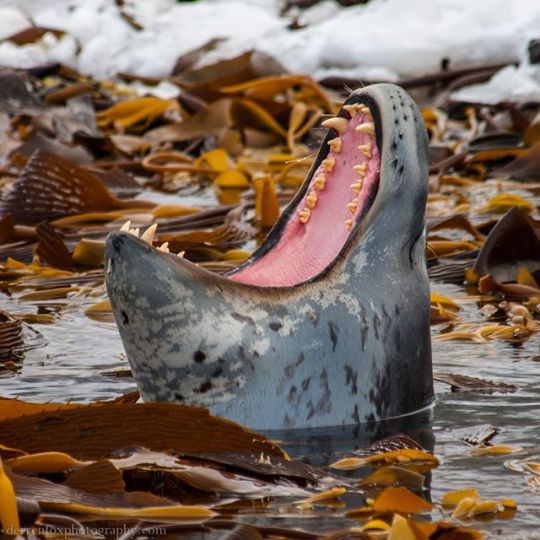
A leopard seal (Hydrurga leptonyx) emerges from the kelp on Bird Island, South Georgia
by Derren Fox
#leopard seal#hydrurga leptonyx#seals#pinnipeds#hydrurga#phocidae#pinnipedia#carnivora#mammalia#chordata#wildlife: south georgia#wildlife: antarctica
13K notes
·
View notes
Text

Elephant seal bulls fight for mating rights at Saint Andrews Bay in South Georgia.
PHOTOGRAPH BY PAUL NICKLEN, NATIONAL GEOGRAPHIC CREATIVE
#paul nicklen#photographer#national geographic#elephant seal bulls#seal#saint andrews bay#south georgia#animal#mammal#wildlife#nature
17 notes
·
View notes
Text





#Diomedea exulans#snowy albatross#wandering albatross#white-winged albatross#juvenile#Diomedeidae#Procellariiformes#Aves#Chordata#south georgia#creative commons#wildlife#nature#animal#bird
2 notes
·
View notes
Text

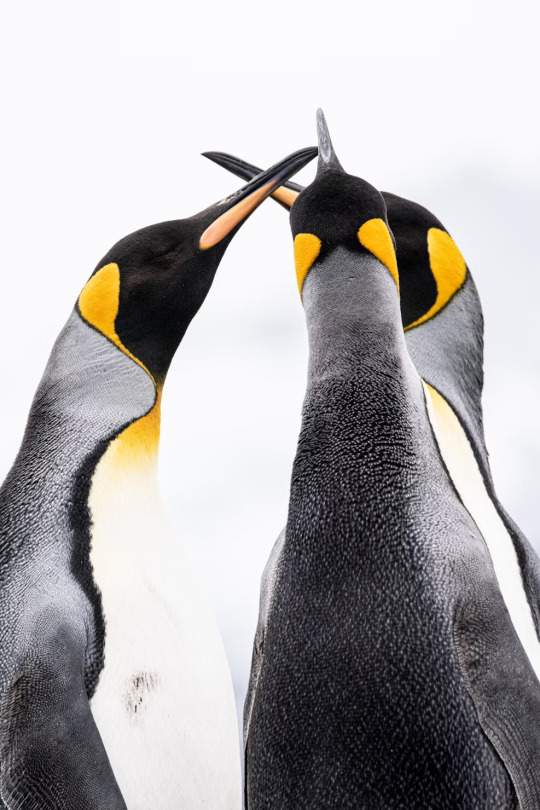

King Penguins in South Georgia and the South Sandwich Islands (British Overseas Territory)
Birger Strahl
Scientific name: Aptenodytes patagonicus
Conservation status: Least Concern (Population increasing)
Mass: 21 – 38 lbs
Family: Spheniscidae
Class: Aves
Domain: Eukaryota
Genus: Aptenodytes
The king penguin is the second largest species of penguin, smaller, but somewhat similar in appearance to the emperor penguin. There are two subspecies, A. p. patagonicus and A. p. halli; patagonicus is found in the South Atlantic and halli in the South Indian Ocean and at Macquarie Island.
#Antarctica#South Georgia and the South Sandwich Islands#British Overseas Territory#British Overseas Territories#British Territory#King Penguins#King Penguin#Penguins#Penguin#Wildlife#AntarcticaWildlife#Birds#Bird
3 notes
·
View notes
Text
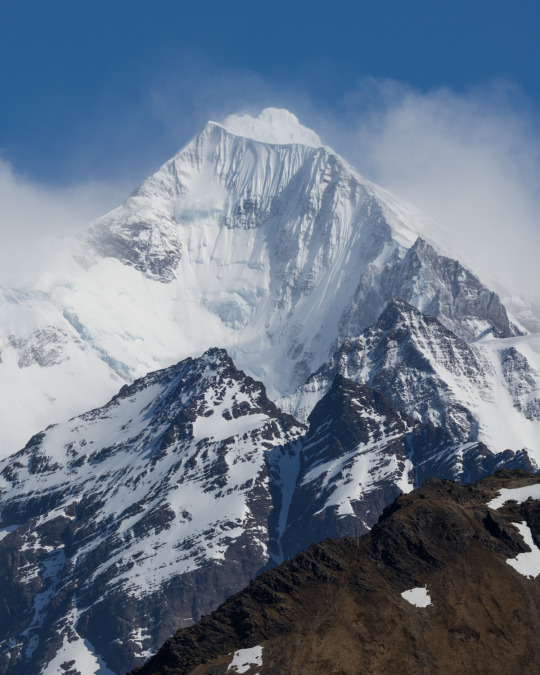
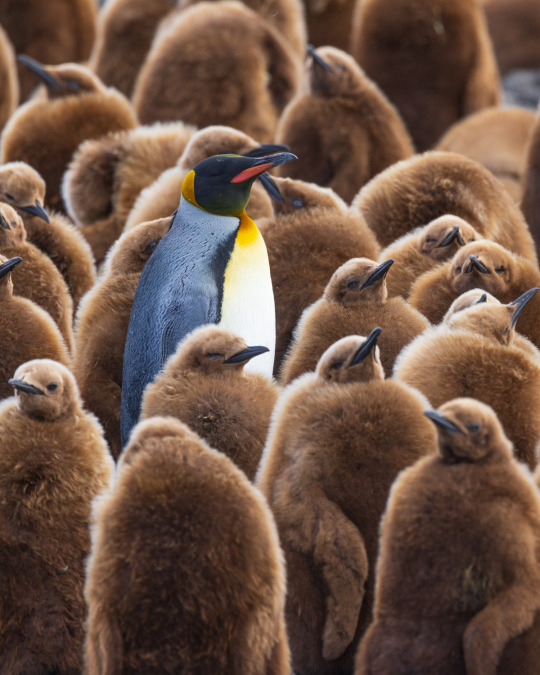


One of the most amazing natural locations in the world - South Georgia Island in the South Atlantic.
📸 by Richard Bernabe
#Richard Bernabe#Penguins#South Georgia Island#South Atlantic#Amazing#Wildlife#Beautiful#Nature#Travel#Adventure#Photography
5 notes
·
View notes
Text

The government of the South Georgia and South Sandwich Islands (SGSSI), which operates as a British overseas territory, recently announced that it had established new no-fishing zones over 166,000 km² (64,100 mi²) of its existing marine protected area, and prohibited krill fishing in an additional 17,000 km² (6,600 mi²) of the MPA.
These new no-fishing zones were established to protect krill-dependent marine wildlife, including baleen whales and penguins, while also considering the fisheries operating in the area, which target krill and other species.
While conservationists initially pushed for further protections, they ultimately accepted the decision, with one calling it a “positive and good outcome.”
However, Argentina, which claims the South Georgia and South Sandwich Islands as part of its Tierra del Fuego province, has expressed its dissatisfaction with the SGSSI government’s decision.
#good news#environmentalism#science#environment#nature#animals#conservation#marine life#marine biology#ocean life
324 notes
·
View notes
Text

12 June 2024
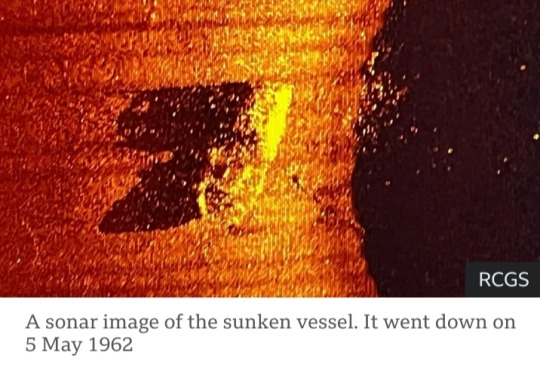
Wreck hunters have found the ship on which the famous polar explorer Ernest Shackleton made his final voyage.
The vessel, called "Quest," has been located on the seafloor off the coast of Newfoundland, Canada.
Shackleton suffered a fatal heart attack on board on 5 January 1922 while trying to reach the Antarctic.
And although Quest continued in service until it sank in 1962, the earlier link with the explorer gives it great historic significance.
The British-Irish adventurer is celebrated for his exploits in Antarctica at a time when very few people had visited the frozen wilderness.
"His final voyage kind of ended that Heroic Age of Exploration, of polar exploration, certainly in the south," said renowned shipwreck hunter David Mearns, who directed the successful search operation.
"Afterwards, it was what you would call the scientific age. In the pantheon of polar ships, Quest is definitely an icon," he told BBC News.
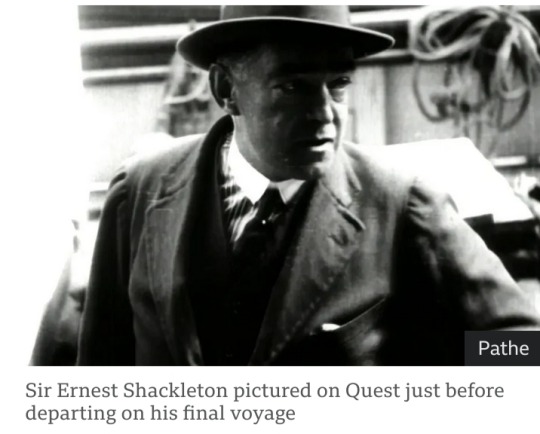
The remains of the ship, a 38m-long schooner-rigged steamship, were discovered at the bottom of the Labrador Sea on Sunday by a team led by The Royal Canadian Geographical Society (RCGS).
Sonar equipment found it in 390m (1,280ft) of water. The wreck is sitting almost upright on a seafloor that has been scoured at some point in the past by the passing of icebergs.
The main mast is broken and hanging over the port side, but otherwise, the ship appears to be broadly intact.
Quest was being used by Norwegian sealers in its last days. Its sinking was caused by thick sea-ice, which pierced the hull and sent it to the deep.
The irony, of course, is this was the exact same damage inflicted on Shackleton's Endurance - the ship he used on his ill-fated Imperial Trans-Antarctic Expedition of 1914–1917.
Fortunately, the crews of both Endurance, in 1915, and Quest, in 1962, survived.
Indeed, many of the men who escaped the Endurance sinking signed up for Shackleton's last polar mission in 1921-1922, using Quest.
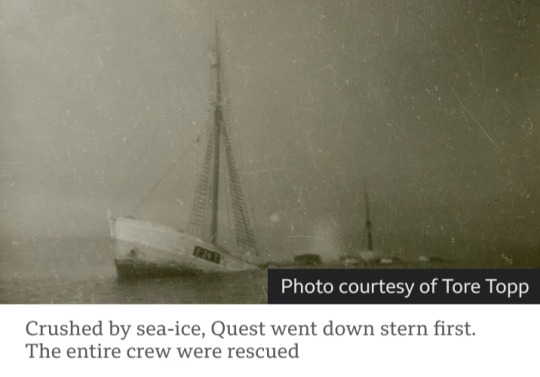
His original plan had been to explore the Arctic, north of Alaska, but when the Canadian government withdrew financial support, the expedition headed south in Quest to the Antarctic.
The new goal was to map Antarctic islands, collect specimens and look for places to install infrastructure, such as weather stations.
Shackleton never made it, however, struck down by heart failure in the Port of Grytviken on the British Overseas Territory of South Georgia, the last stop before reaching the White Continent. He was just 47 years old.
After his death, Quest was involved in other important expeditions, including the 1930-31 British Arctic Air Route Expedition led by British explorer Gino Watkins, who himself tragically died aged 25 while exploring Greenland.
Quest was also employed in Arctic rescues and served in the Royal Canadian Navy during WWII, before being turned over to the sealers.
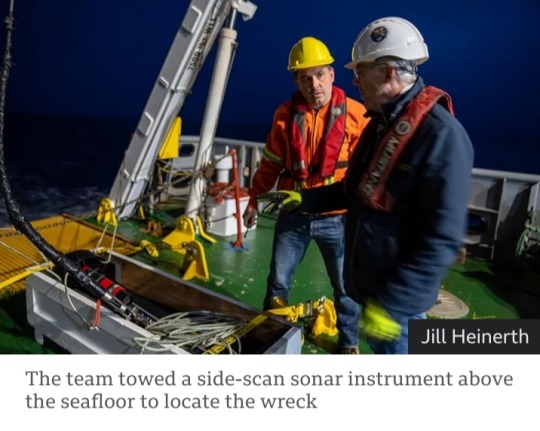
The RCGS team members carried out extensive research to find Quest's last resting place.
Information was gathered from ship's logs, navigation records, photographs, and documents from the inquiry into her loss.
The calculated sinking location in the Labrador Sea was pretty much spot on, although the exact co-ordinates are being held back for the time being.
A second visit to the wreck, possibly later this year, will do a more complete investigation.
"Right now, we don't intend to touch the wreck. It actually lies in an already protected area for wildlife, so nobody should be touching it," associate search director Antoine Normandin said.
"But we do hope to go back and photograph it with a remotely operated vehicle, to really understand its state."
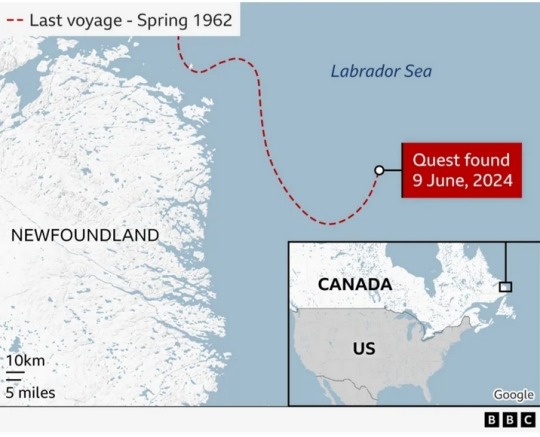
Alexandra Shackleton is the explorer's granddaughter and was patron to the RCGS survey.
"I was thrilled, really excited to hear the news; I have relief and happiness and a huge admiration for the members of the team," she told BBC News.
"For me, this represents the last discovery in the Shackleton story. It completes the circle."
The explorer continues to spark interest more than a century after his death.
Hundreds of people visit his grave on South Georgia every year to pay their respects to the man known by his crews simply as "The Boss."
"Shackleton will live forever as one of the greatest explorers of all time, not just because of what he achieved in exploration but for the way he did it, and the way he looked after his men," said David Mearns.
"His story is timeless and will be told again and again; and I'm just one of many disciples who'll keep telling it for as long as I can."
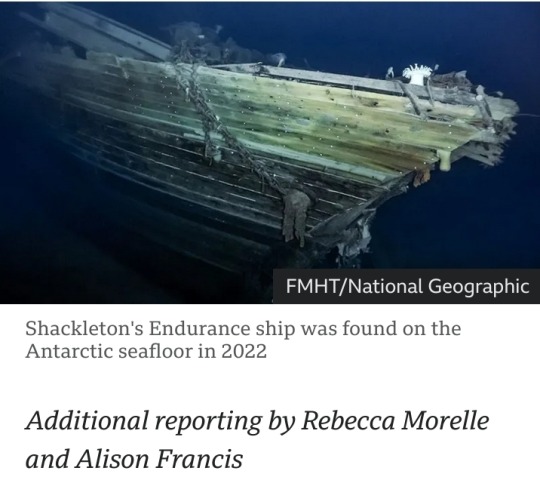
—
Sir Ernest Henry Shackleton CVO OBE FRGS FRSGS (15 February 1874 – 5 January 1922) was an Anglo-Irish Antarctic explorer who led three British expeditions to the Antarctic.
He was one of the principal figures of the period known as the Heroic Age of Antarctic Exploration.
#Ernest Shackleton#Quest#Newfoundland#Canada#Antarctic#polar explorer#shipwreck hunter#shipwreck#Labrador Sea#The Royal Canadian Geographical Society (RCGS)#Endurance#1930-31 British Arctic Air Route Expedition#Gino Watkins#sonar instrument#Heroic Age of Antarctic Exploration#Sir Ernest Henry Shackleton#British expeditions
66 notes
·
View notes
Text
‘Flock of bears’ investigates water bowl outside Florida home. See them snoop
The Georgia native said she didn’t know they would encounter so much wildlife when they moved south, but now it’s one of her favorite things about their home.
“I just want to say that I absolutely love it; it’s scary and beautiful at the same time,” Palmer-Cobb said. “There is nowhere else that I would rather live!”
37 notes
·
View notes
Text

A group of Gentoo penguins (Pygoscelis papua) porpoising in South Georgia
by Gregory "Slobirdr" Smith
#gentoo penguin#penguins#birds#pygoscelis papua#pygoscelis#spheniscidae#sphenisciformes#aves#chordata#wildlife: south georgia
114 notes
·
View notes
Text
"After teetering on the edge of extinction almost 50 years ago, the wood stork is now widespread across the southeastern US, and is preparing a flight off the Endangered Species List (ESL).
It’s all in a day’s work for the ESL, the world’s most successful conservation program in history, and the only stork native to North America is just the most recent beneficiary.
The wood stork faced extinction when listed in 1984 under the Endangered Species Act. The population had decreased from 20,000 nesting pairs to less than 5,000 pairs, primarily nesting in south Florida’s Everglades and Big Cypress ecosystems.
The recovery program worked to restore and protect the ecosystems which the four-and-a-half-foot-tall bird calls home.
Today, the wood stork breeding population has doubled to 10,000 or more nesting pairs and increased its range, including the coastal plains of Mississippi, Alabama, Florida, Georgia, and the Carolinas. These long-legged wading birds more than tripled their number of nesting colonies from 29 to 99 in their expanded range.
US Fish and Wildlife explained they’ve adapted to new nesting areas, moving north into coastal salt marshes, old, flooded rice fields, floodplain forest wetlands, and human-created wetlands.
The Fish and Wildlife Service will take comments on the proposal through April 17th, and even if it is delisted, it would remain a protected species under other legislation such as the Migratory Bird treaty...
“The wood stork is recovering as a result of protecting its habitat at a large scale,” said Assistant Secretary for Fish and Wildlife and Parks Shannon Estenoz. “This iconic species has rebounded because dedicated partners in the Southeast have worked tirelessly to restore ecosystems, such as the Everglades, that support it.”"
-via Good News Network, 2/20/23
#endangered species act#endangered species#biodiversity#conservation#conservation news#everglades#georgia#florida#united states#wetlands#ecosystem restoration#ecosystem#good news#hope
196 notes
·
View notes
Text
President Joe Biden is expected to permanently ban future offshore oil and gas development in parts of the Atlantic and Pacific oceans in a way that could be especially difficult for the incoming Trump administration to undo.
Biden’s planned executive order will invoke the 1953 Outer Continental Shelf Lands Act, a law that gives presidents broad authority to withdraw federal waters from future oil and gas leasing and development, according to an administration source familiar with the plans.
The law does not give presidents explicit authority to revoke the action and place federal waters back into development, meaning President-elect Donald Trump would have to get Congress to change it before he could reverse Biden’s move.
As Biden’s presidency draws to a close, environmental and climate groups have advocated for him to withdraw areas off the Eastern Gulf of Mexico, as well as other parts of the Atlantic and Pacific oceans – giving the areas permanent protections from future drilling. The move would guard against future oil spills and adding more planet-warming pollution from fossil fuels to the atmosphere.
“We hope it will be part of a very vast area,” Oceana campaign director Joseph Gordon told CNN, adding Biden’s actions “would extend and make permanent those protections.”
Despite a friendly posture towards the oil and gas industry, Trump also moved to ban offshore drilling while president. After proposing a major expansion in offshore drilling early in his first term, Trump in 2020 extended a ban on future oil drilling in the Eastern Gulf and expanded it to include the Atlantic coasts of three states: Florida, Georgia and South Carolina.
“Every president this century has recognized that some areas of the ocean are just too risky or too sensitive to drill,” Earthjustice vice president of litigation for lands, wildlife and oceans Drew Caputo said in a statement.
The White House declined to comment. Biden’s move was first reported by Bloomberg.
Energy analysts told CNN the move won’t make much of a difference in US oil production, which has set new records under Biden.
It’s “not particularly consequential for US exploration and production going forward,” said Tom Kloza, global head of energy analysis at the Oil Price Information Service. Kloza noted there’s plenty of existing offshore rigs pumping oil in the Gulf of Mexico and added that offshore projects typically take 6-8 years to come online.
“I don’t see it as having any real impact on US supply, exports, imports,” Kloza said.
Still, the American Petroleum Institute blasted Biden’s decision, calling it a “misguided approach.”
“We look forward to working with the incoming administration to bring the benefits offshore oil and natural gas production provides to the United States through jobs, investment and domestic energy security,” API senior vice president of policy, economics and regulatory affairs Dustin Meyer said in a statement.
In a separate coming announcement, the Biden administration is also expected to declare two new national monuments in California in the coming week, a source familiar with the planning told CNN.
Biden will establish the Chuckwalla National Monument in Southern California near Joshua Tree National Park and the Sáttítla National Monument in Northern California, the source said. Native tribes have been actively pushing the administration to protect the land from energy development.
This ban has now gone ahead
5 notes
·
View notes
Text
Holidays 2.12
Holidays
Bra Day (Japan)
Darwin Day
Flip Flop Day [also 3rd Friday in June]
Gamma Day (Illinois)
Georgia Day (US)
Gold Rush Day (Australia)
Hug Day
Immanuel Kant Remembrance Day
International Darwin Day
International Day Against the Use of Child Soldiers
International Day of the Prevention of Violent Extremism As & When Conducive to Terrorism
International Day of Women’s Health
Janet Jackson Appreciation Day
Lady Jane Grey’s Ghost Appearance Day
Lincoln's Birthday
Lost Penny Day
Love a Mensch Day
Makha Bucha Day (Thailand)
Memorial Day of 1990 Dushanbe Riots (Tajikistan)
Moresdag (Mother’s Day; Norway)
NAACP Day
Nancy Hanks Lincoln Memorial Day (Booneville, Indiana)
National Freedom to Marry Day
National Hump for a Day, Day
National Productivity Day (India)
National Women’s Day (Pakistan)
Oglethorpe Day (a.k.a. Georgia Day; US)
Paul Bunyan Day (Bangor, Maine) [also 8.10]
Peanut’s Remembrance Day
Pick A New Love Song Day
Red Hand Day (UN)
Rhapsody in Blue Day
Robinson Crusoe Rescue Day
Rubber Galoshes Day
Safety Pup Day
Sexual and Reproductive Health Awareness Day (Canada)
Susan B. Anthony Dollar Day
Tourism Day (Taiwan)
World Cholangiocarcinoma Day
World Lidar Day
Youth Day (Venezuela)
Food & Drink Celebrations
Hot Tea Day
National Biscotti Day
National P.B. & J. Day
Plum Pudding Day
Nature Celebrations
Common Knotgrass Day (French Republic)
Justiça Procumbens Day (Pure & Simple; Korean Birth Flowers)
Independence, Flag & Related Days
The Baillium Empire (Declared; 2019) [unrecognized]
Chile (Declared from Spain, 1818)
China (Became a Republic after Overthrow of Manchu Dynasty; 1912)
Commonwealth Day (Gibraltar)
Savannah, Georgia (Founded; 1733)
Sexistan (Declared; 2015) [unrecognized]
Union Day (Union of Burma Founded; 1947)
New Year’s Days
New Year for Trees (Tu Bishvat; Judaism)
2nd Wednesday in February
Hump Day [Every Wednesday]
Wacky Wednesday [Every Wednesday]
Waste-Not Wednesday (UK) [Wednesday of Go Green Week]
Watermelon Wednesday [2nd Wednesday of Each Month]
Website Wednesday [Every Wednesday]
Workout Wednesday [2nd Wednesday of Each Month]
Weekly Holidays beginning February 12 (2nd Week of February)
Borrowed Days (Scotland) [thru 2.14]_
Festivals On or Beginning February 12, 2025
Cheongwoldaeboreum, a.k.a. Korean Folk Festival (North Korea)
Great British Beer Festival Winter (Rotherham, United Kingdom) [thru 2.15]
Kosher Food and Wine Experience (Oxnard, California)
Lantern Festival (China) [Day 15 in Month 1]
National Farm Machinery Show & Tractor Pull (Louisville, Kentucky) [thru 2.15]
Taiwan Lantern Festival (Taoyuan, Taiwan) [thru 2.23]
Watertown Winter Farm Show (Watertown, South Dakota) [thru 2.15]
Feast Days
Aesop (Positivist; Saint)
Anthony Kauleas, Patriarch of Constantinople (Christian; Saint)
Ariadne’s Labyrinth Day (Starza Pagan Book of Days)
Benedict of Aniane (Christian; Saint)
Bruno (Muppetism)
Choes Day (Day of the Cups; Ancient Greece)
Damian of Alexandria (Christian; Saint)
Darwin Day (Pastafarian)
Diana’s Day (Ancient Rome)
Diana’s Day — Protection of Wildlife (Pagan)
Ethelwald of Lindisfarne (Christian; Saint)
Eulalia (Christian; Saint)
Feast of the Seven Founders of the Service Order
Feast of the Three Saints — Basil the Great, Gregory the Theologian (Orthodox Christian)
Festival of Artemis (Goddess of the Hunt; Ancient Greece)
Festival of Pitooyage (God of gaming & chance; Oaxaca, Mexico)
Fritter Thursday [Day after Ash Wednesday]
High Confiscation of Property (Church of the SubGenius)
Julian the Hospitaller (Christian; Saint) [travelers, innkeepers & circus performers]
Ludan (Christian; Saint)
Marina (Christian; Virgin)
Martyrs of Abitinae (Christian; Martyrs)
Meletius, Patriarch of Antioch (Christian; Saint)
Sacrifice to Dionysos (Ancient Greece)
Storm-Days begin (Celtic Book of Days)
Tales of Kelp-Koli (Shamanism)
Hebrew Calendar Holidays [Begins at Sundown Day Before]
Tu Bishvat (New Year for Trees) [14-15 Shevat]
Lunar Calendar Holidays
Chinese: Month 1 (Wu-Yin), Day 15 (Ren-Zi)
Day Pillar: Water Rat
12-Day Officers/12 Gods: Open Day (開 Kai) [Auspicious]
Holidays: Lantern Festival (元宵节)
Full Moon [2nd of the Year] (a.k.a. ...
Bony Moon (Cherokee)
Budding Moon (China)
Daeboreum (Great Full Moon; Korea) [1st Full Moon of Lunar Calendar]
Eagle Moon (Traditional)
Grain Moon (South Africa)
The Great Fifteenth [Lunar Calendar]
Hunger or Hungry Moon (Alternate)
Ice Moon (Celtic)
Little Famine Moon (Choctaw)
Naval Full Moon Poya Day (Sri Lanka)
Raccoon Moon (Traditional)
Snow Moon (American Indian, North America, Traditional)
Southern Hemisphere: Barley, Corn, Dog, Grain, Red, Sturgeon, Wyrt Moons
Storm Moon (England, Neo-Pagan, Wicca)
Trapper’s Moon (Colonial)
Secular Saints Days
Darren Aronofsky (Entertainment)
Max Beckman (Art)
Tex Beneke (Music)
Terry Bisson (Literature)
Judy Blume (Literature)
Omar Bradley (Military)
Rolf Brem (Art)
Charles Darwin (Science)
Friedrich de la Motte Fouqué (Literature)
R. F. Delderfield (Literature)
Jean Effel (Art)
R. Buckminster Fuller (Architecture)
Steve Hackett (Music)
Roy Harris (Music)
Abraham Lincoln (Politics)
Ray Manzarek (Music)
Michael McDonald (Music)
George Meredith (Literature)
Joan Mitchell (Art)
Thomas Moran (Art)
Zoran Mušič (Art)
Anna Pavlova (Dance)
Christina Ricci (Entertainment)
Bill Russell (Sports)
Julian S. Schwinger (Science)
George Simenon (Literature)
Marie Vassilieff (Art)
Franco Zeffirelli (Entertainment)
Lucky & Unlucky Days
Prime Number Day: 43 [14 of 72]
Sakimake (先負 Japan) [Bad luck in the morning, good luck in the afternoon.]
Unfortunate Day (Pagan) [11 of 57]
Premieres
All in Fever Say Aye or The Emotion is Carried (Rocky & Bullwinkle Cartoon, S4, Ep. 204; 1963)
Andy and Min Have a Caller (The Gumps Wallace Carlson Studio Cartoon; 1921)
Andy’s Holiday (The Gumps Wallace Carlson Studio Cartoon; 1921)
Animals, by Pink Floyd (Album; 1977)
Anti-Intellectualism in American Life, by Richard Hofstadter (Non-Fiction Book; 1963)
Emperor Hymn (a.k.a. Gott erhalte Franz den Kaiser), by Joseph Haydn (Austrian Anthem; 1797)
The Automobile Ride (Fleischer Goldwyn-Bray Pictographs Cartoon; 1921)
Beanstalk Bunny (WB MM Cartoon; 1955)
The Best of Luck (The Gumps Wallace Carlson Studio Cartoon; 1921)
Blast from the Past (Film; 1999)
Blow-Up and Other Stories, by Julio Cortázar (Short Stories; 1968)
The Blue Umbrella (Animated Pixar Short; 2013)
Boomerang Bowler or Boris Makes a Comeback (Rocky & Bullwinkle Cartoon, S4, Ep. 203; 1963)
Bunny Mooning (Fleischer Color Classic Cartoon; 1937)
Centennial, by James A. Michener (Historical Novel; 1974)
Chester’s Cat (The Gumps Wallace Carlson Studio Cartoon; 1921)
Crazy Town (Noveltoons Cartoon; 1954)
A Dangerous Girl (Keen cartoon; 1917)
Deadpool (Film; 2016)
Dracula (Film; 1931)
English Settlement, by XTC (Album; 1982)
The Further Adventures of Hardrock Dome (Paramount-Bray Pictographs Cartoon; 1919)
Give ‘er the Gas (The Gumps Wallace Carlson Studio Cartoon; 1921)
Groundhog Day (Film; 1993)
Homeward Bound, by Simon & Garfunkel (Song; 1966)
Hop On Pop, by Dr. Seuss (Children’s Book; 1963)
Il Cuspidore (The Gumps Wallace Carlson Studio Cartoon; 1921)
The International (Film; 2009)
I’ve Got My Love to Keep Me Warm, by Dick Powell and Alice Faye (Song; 1937)
Kittens’ Mittens (Car-Tune Cartoon; 1940)
Life Is Beautiful (Film; 1999)
The Lyin’ Hunter (Krazy Kat Cartoon; 1937)
The Map of Tiny Perfect Things (Film; 2021)
The Masked Ball (The Gumps Wallace Carlson Studio Cartoon; 1921)
Maybe I’m Amazed (Live), by Paul McCartney and Wings (Song; 1977)
Michigan State University (School; 1855)
More Than You Know, recorded by Mildred Bailey (Song; 1942)
Moving Pictures, by Rush (Album; 1981)
NAACP (Civil Rights Organization; 1909)
On Golden Pond (Film; 1982)
On the Avenue (Film; 1937)
Percy Jackson & the Olympians: The Lightning Thief (Film; 2010)
Pink Pest Control (Pink Panther Cartoon; 1969)
Pluto’s Housewarming (Disney Cartoon; 1947)
Porky Chops (WB LT Cartoon; 1949)
Progress (Heasrt-Pathe News Cartoon; 1918)
The Promoters (The Gumps Wallace Carlson Studio Cartoon; 1921)
Rear Window, by Cornell Woolrich (Short Story f.k.a. It Had To Be Murder; 1942)
Rhapsody in Blue, by George Gershwin (Musical Composition; 1924)
Rhythm Lullaby and Bubbling Over, by Earl Hines & His Orchestra (Songs; 1935)
Robocop (Film; 2014)
Rolling Around (The Gumps Wallace Carlson Studio Cartoon; 1921)
Roundabout, by Yes (Song; 1972)
Run to the Hills, by Iron Maiden (Song; 1982)
School Daze (Film; 1988)
The Shot Heard Round the World or The First National Bang (Rocky & Bullwinkle Cartoon, S2, Ep. 98; 1961)
Sign of the Unicorn, by Roger Zelazny (Novel; 1975) [The Chronicles of Amber, #3]
The Son Shower (Aesop’s Film Fable Cartoon; 1928)
The Space Rat or Of Mice and Menace (Rocky & Bullwinkle Cartoon, S2, Ep. 97; 1961)
The Squaw Man (Film; 1914) [1st Film made in Hollywood]
Stay Tuned (WB Cartoon; 1993)
Strictly Ballroom (Film; 1993)
Studebaker (Automobile Company’s 1st Sale; 1902)
The Swooner Crooner (Blue Ribbon Hit Parade Cartoon; 1949)
Taft Playing Golf (Criterion Komic Kartoons Cartoon; 1915)
Tapper (Videogame; 1984)
Times and Patowmack Packet (Newspaper; 1789) [1st D.C. newspaper]
Tom Turk and Daffy (WB LT Cartoon; 1944)
Untamed Heart (Film; 1993)
Vermont Gazette (Newspaper; 1781) [1st Vermont newspaper]
We Give Pink Stamps (Pink Panther Cartoon; 1965)
Whoops! I’m a Cowboy (Betty Boop Cartoon; 1937)
Zoolander 2 (Film; 2016)
Today’s Name Days
Benedikt, Eulalia, Gregor (Austria)
Zvonimir, Zvonko (Croatia)
Slavěna (Czech Republic)
Eulalia (Denmark)
Alma, Alme, Elma, Elme, Elmi (Estonia)
Elma, Elmi (Finland)
Félix (France)
Benedikt, Eulalia (Germany)
Meletios, Meletis, Plotinos (Greece)
Lídia, Lívia (Hungary)
Alessio, Eulalia, Pilerio (Italy)
Karlīna, Karline, Līna (Latvia)
Benediktas, Deimantė, Eulalija, Mantminas (Lithuania)
Randi, Randulf, Ronja (Norway)
Aleksy, Benedykt, Eulalia, Julian, Laurenty, Modest, Nora, Radzim, Trzebisława (Poland)
Meletie (Romania)
Perla (Slovakia)
Eulalia (Spain)
Evelina, Evy (Sweden)
Ulas (Ukraine)
Abra, Abraham, Abram, Bram, Darwin, Ibrahim (USA)
Today’s National Name Days
National Braydon Day
Today is Also…
Day of Year: Day 43 of 2025; 322 days remaining in the year
ISO Week: Day 3 of Week 7 of 2025
Celtic Tree Calendar: Luis (Rowan) [Day 23 of 28]
Chinese: Month 1 (Wu-Yin), Day 15 (Ren-Zi)
Chinese Year of the: Snake 4723 (until February 17, 2026) [Ding-Chou]
Coptic: 5 Amshir 1741
Druid Tree Calendar: Hackberry (Feb 9-18) [Day 4 of 10]
Hebrew: 14 Shevat 5785
Islamic: 13 Sha’ban 1446
Julian: 30 January 2025
Moon: 100%: Full Moon
Positivist: 15 Homer (2nd Month) [Aesop)
Runic Half Month: Sigel (Sun) [Day 7 of 15]
Season: Winter (Day 54 of 90)
SUn Calendar: 13 Gray; Sixthday [13 of 30]
Week: 2nd Week of February
Zodiac:
Tropical (Typical) Zodiac: Aquarius (Day 24 of 30)
Sidereal Zodiac: Capricorn (Day 29 of 29)
Schmidt Zodiac: Capricorn (Day 18 of 27)
IAU Boundaries (Current) Zodiac: Capricorn (Day 24 of 28)
IAU Boundaries (1977) Zodiac: Capricornus (Day 25 of 28)
4 notes
·
View notes
Text
Human Movement into Europe

source: https://www.nature.com/articles/s41467-025-56154-9
It is uncertain when exactly hominins entered Europe from Africa via the Middle East. The most recent evidence was in Damanisi Georgia, which dated to 1.8 million years ago with ephemeral traces in the rest of Europe to about 1.4 million years ago.
A paper released in January 2025 presented evidence of hominins in Grăunceanu, Romania that date to 1.95 million years ago. The study took place in the Olteţ River Valley of Romania, south of the Carpathian Mountains. This area was initially studied in the 1960s and was found to have a rich variety of wildlife, including mammoth, bovid, rhinocerotids, and many species of carnivores and rodents. These earlier studies didn't find direct evidence of hominins.

source: https://www.nature.com/articles/s41467-025-56154-9
The recent study found 4524 specimens of bones that had been previously excavated that they studied under low-angled light for evidence of changes to the surface of the bones. In these fossils, they found 1189 that had linear marks, though most of these were identified as tooth or trampling marks as well as some that were from an excavator with 411 from an uncertain origin. Twenty specimens showed cut marks, seven of which were 'high confidence', twelve with probable, and one with both types.
These specimens were dated by testing where along the decay chain between uranium to lead to find where the majority of the isotopes are, which gave ages from 2.01 million years at the highest end to 1.87 million years at the lowest.
They then tested the stable isotopes of carbon and oxygen, which then gave them an annual temperature of about 4°C, which conflicted with the evidence of warm weather adapted animals. The researchers hypothesized that this conflict could come down to the isotopes found in the rainfall in the area, but evidence of where rain came from in an area during the Early Pleistocene. Another explanation is there was greater winter accumulation of snow and lower temperatures which pushed down the overall temperature of the year or that the animals in the area drank water that had an isotopic signature from winter melt water.
Despite finding evidence of tool use, no tools have been found, nor have hominin bones been found. This is not a unique problem to the Grăunceanu, Romania location, but also to certain sites in eastern Africa. The team at Grăunceanu took great pains to make sure their classifications of high confidence marks wouldn't be reclassified by further study. They also don't make any guesses as to what type of hominin made the marks as this time period had several hominins that might have coexisted in the area.
4 notes
·
View notes
Text

"A Formal Occasion" South Georgia Island by Richard BernabeNew cover photo on Richard's Website: richardbernabe.com
1 note
·
View note
Text
Moth of the Week
Hummingbird Clearwing Moth
Hemaris thysbe

The hummingbird clearwing moth is a part of the family Sphingidae or the hawkmoth family and was first described by Johan Christian Fabricius in 1775. The name Hemaris Thysbe is thought to be a reference to Thisbe, one of the doomed lovers in Ovid's Metamorphoses, due to the color of Thisbe’s blood-stained scarf and the maroon color of the moth. Additionally, the name hummingbird clearwing is due to the humming noise created by the rapid flapping of the moth’s transparent wings.
Description The hummingbird clearwing moth typically has an olive green and maroon back with a white or yellow and maroon underside. It has pale legs and no stripes, which is how you tell this moth apart from other in its genus, Hemaris. Its wings are transparent with a maroon border. After hatching, the hummingbird clearwing’s wings are a fully opaque dark red to black. Then the wing’s scales fall off when the moth takes flight, resulting in a clear wing with maroon borders and visible veins. However, a moth’s color and wing patterning varies between individual moths. For example, moths born in the south or later in the mating season are darker in color, and different populations have varying wing border shapes.
Average wingspan of 4.75 cm (≈1.9 in)
Up to 70 wingbeats per second
Can fly up to 12 mph (≈19.3 kph)
Diet and Habitat When in their caterpillar stage, these moths eat the leaves of cherry trees, European cranberry bushes, hawthorns, dogbane, honeysuckle, and snowberry bushes. Adult hummingbird moths feed on the nectar from flowers such as the Wild Bergamot and beebalm, red clovers, lilacs, phloxs, snowberry, cranberry, blueberry, vetch and thistle. The hummingbird clearwing prefers purple and pink flowers. They use their long proboscis or feeding tube to collect nectar from the flowers while flying in front of it like a hummingbird.
The average proboscis is 20 mm (≈0.8 in)
These moths are the most common in southern Ontario and the eastern United States. Their habitat ranges from Alaska to Oregon in the west and from Newfoundland to Florida in the east. They migrate northward from April to August and southward in late spring and the fall. They inhabit forests, meadows, and suburban gardens.
Mating The hummingbird clearwing has two broods a year in the south, but only one in the north. Mating takes place in May and June as females attract males with pheromones produce from glands at the tip of the abdomen. Female hummingbird moths will lay 200 eggs that will hatch in only 6 to 8 days.
Predators Hummingbird moths and caterpillars in general are hunted by birds, mantids, spiders, bats. To help protect themselves, these types of moths resemble hummingbirds or bees to fool predators.
Fun Fact Adults hummingbird clearwing moths are most active during the hottest parts of the day and have no hearing abilities due to a lack of “hearing organs.”
(Source: Wikipedia, Life On CSG Pond, United States Department of Agriculture, Georgia Wildlife Federation, Beyond Pest Control)
#animals#bugs#facts#insects#libraryofmoths#moth#mothoftheweek#lepidoptera#Sphingidae#hummingbird clearwing moth#Hemaris thysbe
120 notes
·
View notes
Text

Excerpt from this story from WTSP:
New research is showing that the majority of gopher tortoises could be at risk of extinction in less than 80 years.
According to a study from the Center for Biological Diversity, a new model that details population viability for the tortoises predicts that less than 1% of the species will be around by the year 2100.
This comes after a previous model was discovered to have several errors and overestimated future tortoise populations. It stated that 67% would be around in the same time period.
The flawed model was used so the U.S. Fish and Wildlife Service could deny the species protections from the Endangered Species Act back in 2022, the study explains.
“The previous model was far too flawed to use as a basis for decision making,” said Kevin Shoemaker, Ph.D., a professor of population ecology, in a statement. “I hope the Service does the right thing and re-evaluates their decision. In the meantime, researchers should move quickly to develop a more realistic model to support conservation decisions for this ecologically important species.”
Other errors discovered in the model include a movement of gopher tortoises that produced an "inadvertent positive feedback loop," indicating that the populations were growing faster than biologically possible.
The study also learned the previous model accelerated the rate of sexual maturation of younger gopher tortoises, causing inflated population growth predictions.
“Demographic models are powerful predictive tools for wildlife management decisions, but it’s critical that they be constructed correctly and that the parameters are based on sound scientific data. Unfortunately, the original model that was used to predict the future survival of gopher tortoise populations was significantly flawed and resulted in an erroneous decision by the Service,” said Matthew Aresco, Ph.D., biologist and board member at Nokuse Education, Inc, in a statement.
Researchers explain that the U.S. Fish and Wildlife Service denied protections from the Endangered Species Act for gopher tortoise populations in Florida, Georgia, South Carolina and most of Alabama. Tortoises in Louisiana, Mississippi and western Alabama were allowed protections.
4 notes
·
View notes